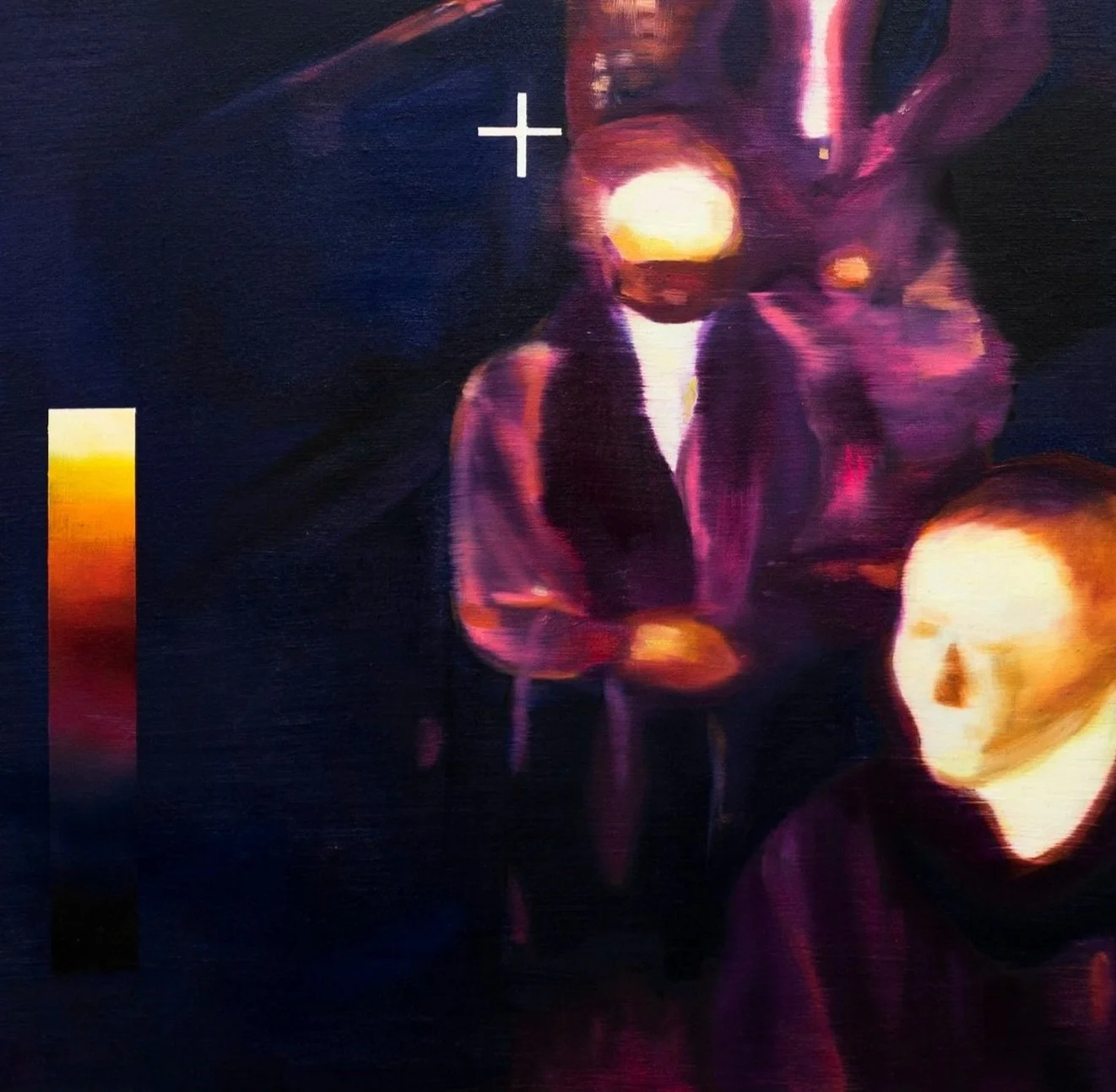Thermal Imaging, 2022
Thermal Imaging, 2022
Oil on linen
76 x 76 cm (30 x 30 in)
Thermal Imaging (2022) is a painting based on a sourced image captured through a thermal imaging camera during the COVID-19 pandemic at an airport security checkpoint. In the center of the composition, two pedestrians wearing masks are highlighted, while a color legend in the bottom left corner corresponds to a scale of temperatures. The “plus” sign visible on the image signifies an artificial intelligence system actively detecting the body temperature of each individual.
The painting employs a vivid palette to represent heat levels that the human eye cannot perceive, offering a visual interpretation of this otherwise invisible phenomenon. Through this work, Tan Mu reflects on how technological advancements, such as thermal imaging and AI, have been integrated into public health monitoring. It captures the tension between the necessity of surveillance and the alienating experience of being observed and measured during a global crisis.
Q: What drew you to use thermal imaging as a subject for your painting?
Tan Mu: I chose thermal imaging as a subject because it captures the warmth of our bodies, transforming it into colors through the lens of a machine. Each hue corresponds to a specific temperature, acting as both a conveyor of information and a translator of sensory experiences—from tactile to visual perception. During the COVID-19 pandemic, temperature became a critical indicator of illness, with technologies like temperature monitoring, thermal imaging, and AI systems widely deployed in public spaces. The image I based this painting on depicts an airport security checkpoint captured through an infrared thermal camera. At the same time, this thermal imaging serves as a metaphor for disconnection. Technology mediates our interactions, converting something as intimate and tactile as body warmth into a purely visual perception. Through this translation, I aim to explore the tension between the technological representation of humanity and the sensory experience it replaces.
Q: How do you approach translating the data-driven visuals of thermal imaging into an artistic form?
Tan Mu: My painting retains the symbolic elements of this technological image: the crosshair represents an AI system actively detecting and recording individuals' body temperatures, while the gradient color bar in the bottom left corner corresponds to temperature levels, aiding in the classification of thermal ranges.
The painting predominantly uses dark and cool tones, with purple, blue, and black occupying most of the canvas. Warm hues like orange and red form a stark contrast, highlighting the temperature differences between people and objects in the image. This contrast directs the viewer's gaze towards the color bar, subtly suggesting the presence of thermal imaging technology. The figures in the painting are rendered in a loose figurative style, with visible brushstrokes that maintain a dynamic effect while blurring the finer details, allowing the figures to be perceived in a more abstract and fluid manner.
Q: How does this painting reflect your core artistic approach to the visible and the invisible?
Tan Mu: From the perspective of painting language, this work can be seen as an interpretation of the visible image and the invisible concepts behind it. The relationship between the visible and the invisible is presented through my choice of subject, painting techniques, and creative process. Thermal imaging technology is a visualization of the invisible tactile sense, transforming it into what we can ‘see’. Through the depiction of technological symbols and relatively figurative representations of the figures, viewers are able to directly understand and perceive the image while grasping the underlying artistic exploration.
At the same time, through visual language such as color contrast and composition, this painting captures the exploration of ‘invisible laws’ like emotions, energy flow, and balance, revealing the essence hidden beneath the surface. The visible image connects closely with the invisible, reflecting on the relationship between technology and humanity. By expressing a balance between the figurative and the abstract, I aim to convey a way of observing the world—focusing on the apparent external existence while also seeking the hidden, underlying connections and patterns. Both elements complement each other, together constructing a complete system of artistic language.
Q: How do you think the development of technology affects our senses, and how do advancements in technologies impact our sense of individuality and privacy?
Tan Mu: For me, technology is a deeply social phenomenon, and I am very interested in how we build networks and information systems. The most significant change has been in the way we communicate and interact, which also brings up ethical concerns regarding personal information and privacy. On one hand, technology has expanded our senses, creating interconnectedness between them. For example, thermal imaging and AI tracking technologies allow us to link our tactile sense of temperature with our visual sense, enabling us to perceive temperature through digital imagery and colors. Before the invention of thermometers, people had to physically step into the real world and sense temperature through their skin, but now, we can perceive temperature visually, simply by looking at weather maps or the numbers on a thermometer.
On the other hand, AI captures and displays this private temperature data on public screens, which raises concerns about privacy breaches. In Thermal Imaging (2022), the background in the upper right corner of the image reveals this metaphor by depicting blurred figures at an airport opening private luggage, returning to the main focus on temperature detection, and mapping the boundary between private and public information. My work not only addresses the technological elements themselves but also the profound social impact they have on privacy, such as body data and informational data. In my 2021 works Privacy 1 and 2, I delve deeper into the relationship between technology and privacy, exploring network and technological security through the imagery of stamps that protect privacy.


